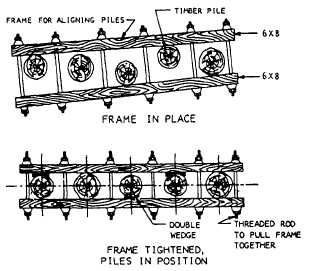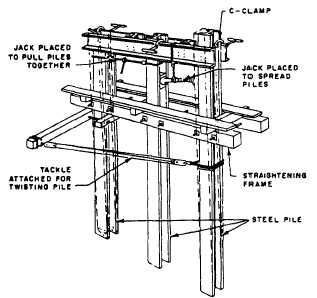alignment desirable for a finished job depends on vari-
ous factors. Generally, though, a pile more than a few
inches out of its plumb line should be trued. The greater
the penetration along the wrong line, the harder to get
the pile back into plumb. There are several methods of
realigning a pile.
One method of realignment is to use pull from a
block and tackle, with the impact of the hammer jarring
the pile back into line (fig. 10-18). The straightening of
steel bearing piles must include twisting the individual
piles to bring the webs of the piles parallel to the center
line of the bent.
Another method of realignment is to use a jet (fig.
10-19), either alone or with either of the other two
methods. Jetting a pile can be done with either water or
air.
When all piles in a bent have been driven, they can
be pulled into proper spacing and alignment with a
block and tackle and an aligning frame, as shown in
figures 10-20 and 10-21.
Pulling
A pile that has hit an obstruction, has been driven
in the wrong place, has been split or broken in driving,
or is to be salvaged (steel sheet piles are frequently
salvaged for reuse) is usually pulled (extracted).
Pulling should be done as soon as possible after
driving. The longer the pile stays in the soil, the more
compact the soil becomes, and the greater the
resistance to pulling will be.
Figure 10-19.-Realigning pile by jetting.
Figure 10-20.-Aligning framing used for timber pile bent.
Figure 10-21.-Aligning and capping steel pile bents.
WATERFRONT STRUCTURES
LEARNING OBJECTIVE: Upon completing
this section, you should be able to describe the
uses of and construction methods for offshore,
alongshore, wharfage, and below the water
table construction.
Waterfront structures are broadly divided into three
main categories: offshore structures creating a sheltered
harbor; alongshore structures establishing and main-
taining a stable shoreline; and wharfage structures
allowing vessels to lie alongside for loading or unload-
ing.
10-11






